Solar eclipse of June 11, 1983
A total solar eclipse occurred at the Moon's ascending node of the orbit on June 11, 1983. A solar eclipse occurs when the Moon passes between Earth and the Sun, thereby totally or partly obscuring the image of the Sun for a viewer on Earth. A total solar eclipse occurs when the Moon's apparent diameter is larger than the Sun's, blocking all direct sunlight, turning day into darkness. Totality occurs in a narrow path across Earth's surface, with the partial solar eclipse visible over a surrounding region thousands of kilometres wide. Occurring only 48 hours before perigee (Perigee on June 13, 1983), the Moon's apparent diameter was larger.
| Solar eclipse of June 11, 1983 | |
|---|---|
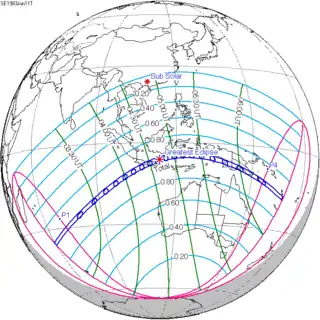 Map | |
| Type of eclipse | |
| Nature | Total |
| Gamma | −0.4947 |
| Magnitude | 1.0524 |
| Maximum eclipse | |
| Duration | 311 sec (5 m 11 s) |
| Coordinates | 6.2°S 114.2°E |
| Max. width of band | 199 km (124 mi) |
| Times (UTC) | |
| Greatest eclipse | 4:43:33 |
| References | |
| Saros | 127 (56 of 82) |
| Catalog # (SE5000) | 9472 |
The path of totality went through Christmas Islands, Indonesia, Papua New Guinea, and terminated in Vanuatu. Maximum eclipse occurred off the Indonesian island of Madura. Major Indonesian cities witnessed totality, including Yogyakarta, Semarang, Surabaya, and Makassar, in addition to Port Moresby in Papua New Guinea.
Restrictions of observation
To avoid blindness, then president of Indonesia Soeharto prohibited local people from observing the eclipse directly through then Information Minister Harmoko, only allowing foreigners to observe from faraway places. Besides the requirements of closing and draping over all windows and airshafts, children were asked to hide themselves in cupboards and below desks as the eclipsing sun's rays were said to be more dangerous to children than to adults. They were allowed to watch a live broadcast of the eclipse occurring over Borobudur Temple in Magelang, Central Java, on state-owned TV channel TVRI. Because of the difference in restriction's intensity between regions, some locals did observe it.[1]
Observation
The Chinese Eclipse Observation Team formed by Beijing Astronomical Observatory (now incorporated into the National Astronomical Observatories of China), Purple Mountain Observatory and Nanjing Astronomical Instrument Factory conducted observation in Port Moresby. Observation in Port Moresby was successful due to the cloudless weather during the eclipse, compared with the cloudy weather in Yogyakarta where teams from many countries went. The Chinese team did spectrum observations of the chromosphere and corona, the broadband corona luminosity and polarization, and the coloured photography of the whole eclipse process.[2]
Related eclipses
Eclipses in 1983
- A total solar eclipse at the Moon's ascending node of the orbit on Saturday, June 11th, 1983.
- A partial lunar eclipse at the Moon's descending node of the orbit on Saturday, June 25th, 1983.
- An annular solar eclipse at the Moon's descending node of the orbit on Sunday, December 04th, 1983.
- A penumbral lunar eclipse at the Moon's ascending node of the orbit on Tuesday, December 20th, 1983.
Solar eclipses of 1982–1985
This eclipse is a member of a semester series. An eclipse in a semester series of solar eclipses repeats approximately every 177 days and 4 hours (a semester) at alternating nodes of the Moon's orbit.[3]
Note: Partial solar eclipses on January 25, 1982 and July 20, 1982 occur in the previous lunar year eclipse set.
| Solar eclipse series sets from 1982–1985 | ||||||
|---|---|---|---|---|---|---|
| Ascending node | Descending node | |||||
| Saros | Map | Gamma | Saros | Map | Gamma | |
| 117 | 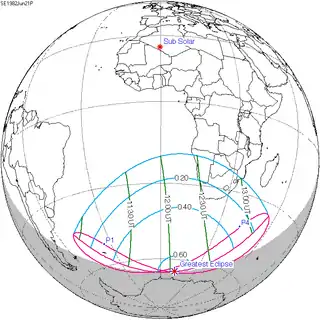 1982 June 21 Partial | −1.21017 | 122 |  1982 December 15 Partial | 1.12928 | |
| 127 |  1983 June 11 Total | −0.49475 | 132 |  1983 December 4 Annular | 0.40150 | |
| 137 |  1984 May 30 Annular | 0.27552 | 142 Partial from Gisborne, NZ |  1984 November 22 Total | −0.31318 | |
| 147 | 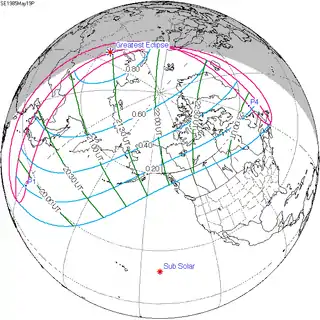 1985 May 19 Partial | 1.07197 | 152 |  1985 November 12 Total | −0.97948 | |
Saros 127
It is a part of Saros cycle 127, repeating every 18 years, 11 days, containing 82 events. The series started with partial solar eclipse on October 10, 991 AD. It contains total eclipses from May 14, 1352 through August 15, 2091. There are no annular eclipses in this series. The series ends at member 82 as a partial eclipse on March 21, 2452. The longest duration of totality was 5 minutes, 40 seconds on August 30, 1532. All eclipses in this series occurs at the Moon’s ascending node.[4]
| Series members 52–68 occur between 1901 and 2200 | ||
|---|---|---|
| 52 | 53 | 54 |
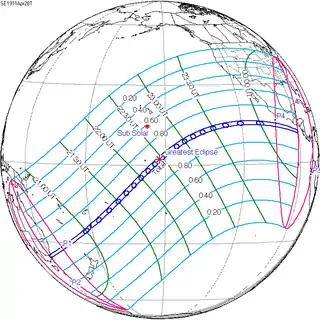 April 28, 1911 |
 May 9, 1929 |
 May 20, 1947 |
| 55 | 56 | 57 |
 May 30, 1965 |
 June 11, 1983 |
 June 21, 2001 |
| 58 | 59 | 60 |
 July 2, 2019 |
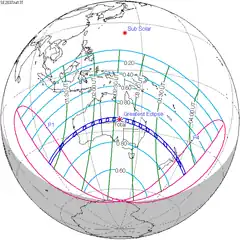 July 13, 2037 |
 July 24, 2055 |
| 61 | 62 | 63 |
 August 3, 2073 |
 August 15, 2091 |
August 26, 2109 (Partial) |
| 64 | 65 | 66 |
| September 6, 2127 (Partial | September 16, 2145 (Partial) | September 28, 2163 (Partial) |
| 67 | 68 | |
| October 8, 2181 (Partial) | October 19, 2199 (Partial) | |
Metonic series
The metonic series repeats eclipses every 19 years (6939.69 days), lasting about 5 cycles. Eclipses occur in nearly the same calendar date. In addition, the octon subseries repeats 1/5 of that or every 3.8 years (1387.94 days). All eclipses in this table occur at the Moon's ascending node.
| 21 eclipse events, progressing from south to north between June 10, 1964, and August 21, 2036 | ||||
|---|---|---|---|---|
| June 10–11 | March 27–29 | January 15–16 | November 3 | August 21–22 |
| 117 | 119 | 121 | 123 | 125 |
 June 10, 1964 |
 March 28, 1968 |
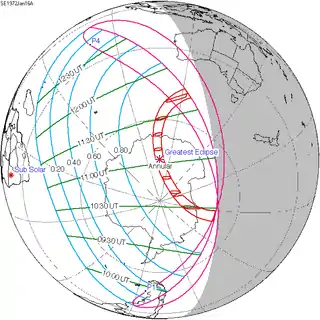 January 16, 1972 |
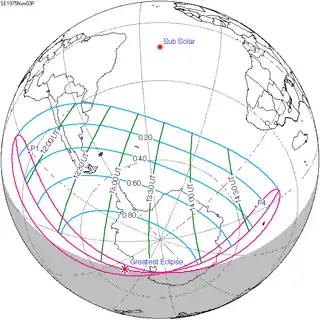 November 3, 1975 |
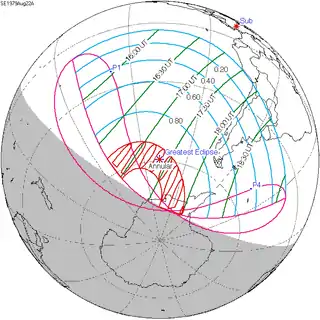 August 22, 1979 |
| 127 | 129 | 131 | 133 | 135 |
 June 11, 1983 |
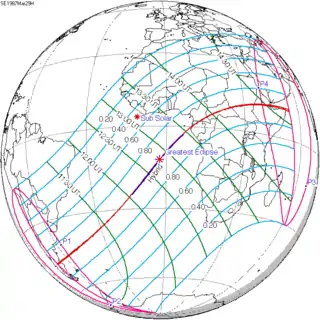 March 29, 1987 |
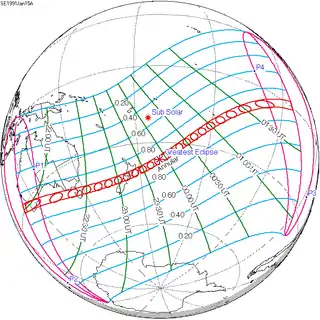 January 15, 1991 |
 November 3, 1994 |
 August 22, 1998 |
| 137 | 139 | 141 | 143 | 145 |
 June 10, 2002 |
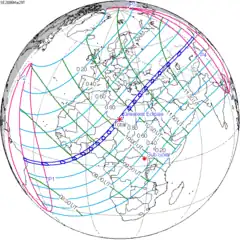 March 29, 2006 |
 January 15, 2010 |
 November 3, 2013 |
 August 21, 2017 |
| 147 | 149 | 151 | 153 | 155 |
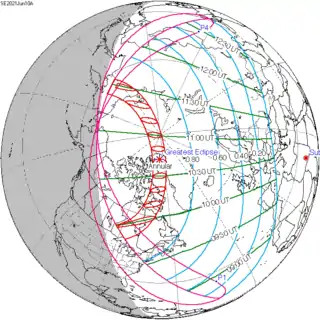 June 10, 2021 |
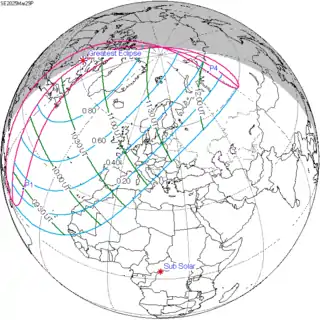 March 29, 2025 |
 January 14, 2029 |
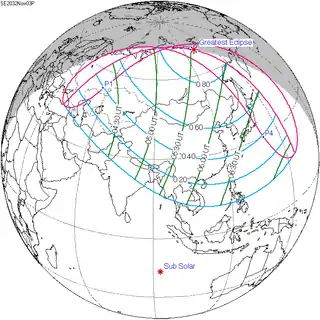 November 3, 2032 |
 August 21, 2036 |
Inex series
This eclipse is a part of the long period inex cycle, repeating at alternating nodes, every 358 synodic months (≈ 10,571.95 days, or 29 years minus 20 days). Their appearance and longitude are irregular due to a lack of synchronization with the anomalistic month (period of perigee). However, groupings of 3 inex cycles (≈ 87 years minus 2 months) comes close (≈ 1,151.02 anomalistic months), so eclipses are similar in these groupings.
| Inex series members between 1901 and 2100: | ||
|---|---|---|
 July 20, 1925 (Saros 125) |
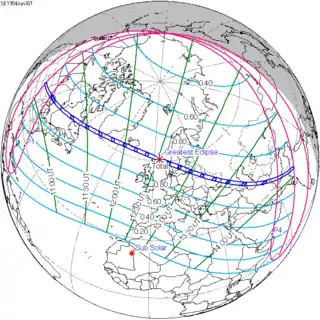 June 30, 1954 (Saros 126) |
 June 11, 1983 (Saros 127) |
 May 20, 2012 (Saros 128) |
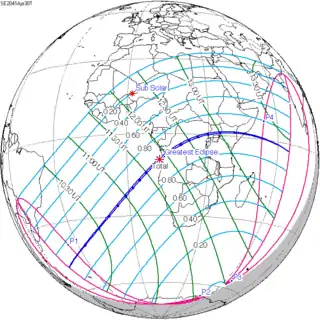 April 30, 2041 (Saros 129) |
 April 11, 2070 (Saros 130) |
 March 21, 2099 (Saros 131) |
||
Notes
- M Zaid Wahyudi. "Avoiding repeat of bitter memory of 1983 total eclipse". Kompas. Archived from the original on 7 March 2016.
- 中国日食观测队天文组 (1983). "1983年6月11日日全食的光学观测". 天文学进展. 1 (2): 246–247.
- van Gent, R.H. "Solar- and Lunar-Eclipse Predictions from Antiquity to the Present". A Catalogue of Eclipse Cycles. Utrecht University. Retrieved 6 October 2018.
- "Solar Saros series 127". NASA Goddard Space Flight Center. NASA. Retrieved 2 November 2017.
References
- Earth visibility chart and eclipse statistics Eclipse Predictions by Fred Espenak, NASA/GSFC
Photos:
.jpg.webp)

